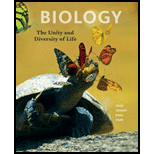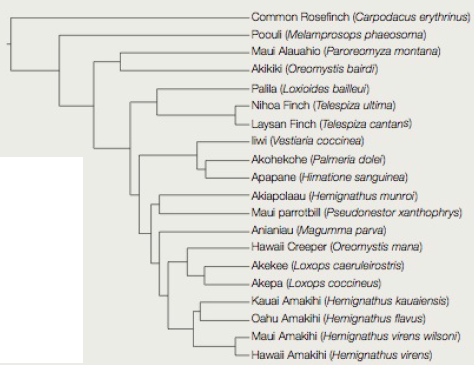
Concept explainers
Hawaiian Honeycreeper Phylogeny
The Poouli (Melamprosops phaeosoma) was discovered in 1973 by a group or students from the University of Hawaii. Its membership in the Hawaiian honeycreeper clade was (until recently) controversial, mainly because its appearance and behavior are so different from other living honeycreepers. Its particularly lacked the “old tent” odor characteristic of other honeycreepers.
In 2011, Heather Lerner and her colleagues deciphered phylogeny of the 19 Hawaiian honeycreepers that were not yet officially declared to be extinct at the time, including the Poouli. The researchers sequenced mitochondrial and nuclear DNA samples taken from the honeycreepers, and also from 28 other birds (outgroups). Phylogenetic analysis of these data firmly establishes the Poouli as a member of the clade, and also reveals the Eurasian rosefinch as the clade’s closest relative (FIGURE 18.11).

FIGURE 18.11 Hawaiian honeycreeper phylogeny. This cladogram was constructed using sequence comparisons of mitochondrial DNA (whole genome), and 13 nuclear DNA loci of 19 Hawaiian honeycreeper and 28 other finch species.
3. What is the sister group of the Akikiki (Oreomystis bairdi)?
Want to see the full answer?
Check out a sample textbook solution
Chapter 18 Solutions
Biology: The Unity and Diversity of Life (MindTap Course List)
- Hawaiian Honeycreeper Phylogeny The po'ouli (Melamprosops phaeosoma) was discovered in 1973 by a group of students from the University of Hawaii. Its membership in the Hawaiian honeycreeper clade had been controversial, mainly because its appearance and behavior are so different from other living honeycreepers. It particularly lacked the "old tent" odor characteristic of other honeycreepers. In 2011, Heather Lerner and her colleagues deciphered phylogeny of the 19 Hawaiian honeycreepers that were not yet officially declared to be extinct at the time, including the po'ouli. The researchers sequenced mitochondrial and nuclear DNA samples taken from the honeycreepers, and also from 28 other birds (outgroups). Phylogenetic analysis of these data firmly establishes the po'ouli as a member of the clade, and also reveals the Eurasian rosefinch as the clade's closest relative (FIGURE 18.10). FIGURE 18.10 Phylogeny of Hawaiian honeycreepers. This cladogram was constructed using sequence comparisons of mitochondrial DNA (whole genome), and 13 nuclear DNA loci of 19 Hawaiian honeycreepers and 28 other finch species. Which species is more closely related to the Palila (Loxioides bailleui): the Tiwi (Vestiaria coccinea) or the Maui 'Alauahio (Paroreomyza montana)?arrow_forwardHawaiian Honeycreeper Phylogeny The po'ouli (Melamprosops phaeosoma) was discovered in 1973 by a group of students from the University of Hawaii. Its membership in the Hawaiian honeycreeper clade had been controversial, mainly because its appearance and behavior are so different from other living honeycreepers. It particularly lacked the "old tent" odor characteristic of other honeycreepers. In 2011, Heather Lerner and her colleagues deciphered phylogeny of the 19 Hawaiian honeycreepers that were not yet officially declared to be extinct at the time, including the po'ouli. The researchers sequenced mitochondrial and nuclear DNA samples taken from the honeycreepers, and also from 28 other birds (outgroups). Phylogenetic analysis of these data firmly establishes the po'ouli as a member of the clade, and also reveals the Eurasian rosefinch as the clade's closest relative (FIGURE 18.10). FIGURE 18.10 Phylogeny of Hawaiian honeycreepers. This cladogram was constructed using sequence comparisons of mitochondrial DNA (whole genome), and 13 nuclear DNA loci of 19 Hawaiian honeycreepers and 28 other finch species. Which species is most closely related to the 'Apapane (Himatione sanguinea)?arrow_forwardHawaiian Honeycreeper Phylogeny The po'ouli (Melamprosops phaeosoma) was discovered in 1973 by a group of students from the University of Hawaii. Its membership in the Hawaiian honeycreeper clade had been controversial, mainly because its appearance and behavior are so different from other living honeycreepers. It particularly lacked the "old tent" odor characteristic of other honeycreepers. In 2011, Heather Lerner and her colleagues deciphered phylogeny of the 19 Hawaiian honeycreepers that were not yet officially declared to be extinct at the time, including the po'ouli. The researchers sequenced mitochondrial and nuclear DNA samples taken from the honeycreepers, and also from 28 other birds (outgroups). Phylogenetic analysis of these data firmly establishes the po'ouli as a member of the clade, and also reveals the Eurasian rosefinch as the clade's closest relative (FIGURE 18.10). FIGURE 18.10 Phylogeny of Hawaiian honeycreepers. This cladogram was constructed using sequence comparisons of mitochondrial DNA (whole genome), and 13 nuclear DNA loci of 19 Hawaiian honeycreepers and 28 other finch species. What is the sister group of the 'Akikiki (Oreomystis bairdi)arrow_forward
- Answer each item with either “Yes” or “No”. If the answer is No, write a 1-sentence statement that gives the correct interpretation of the relationship of the species mentioned. 1. pinea and heldrechii are sister to each other 2. merkusii is equally related to heldreichii and pinea 3. The group consisting only of (longaeva, brutia and sylvestris) is polyphyletic. 4. The group consisting only of (heldreichii, bruita and pinea) is polyphyletic.arrow_forwardList any three (3) families of agricultural importance in the suborder Auchenorrhynchaarrow_forwardList any three (3) families of agricultural importance in the suborder Auchenorrhyncha, AND indicate why they are important.arrow_forward
- Morphological Information Baltimore Oriole Black-backed Oriole Female Male Kondo, Baker, & Omland 2004 2B. Based on the morphological information above, should the Baltimore Oriole and Black- backed Oriole be classified as one species or two species? What if we only had information about females?arrow_forwardMake a phylogenetic tree just including the following= phylum nematoda (enoplea and chromadorea) phylum nematomorpha Phylum Priapulida Phylum Kinorhyncha Phylum Loricifera Phylum Tardigrada Phylum Onychophora Phylum arthropoda -include subphylums and classesarrow_forwardWhat is the sister group to Innovatiocaris maotianshanensis? The phylogeny shows that some named groups are not monophyletic. For each of the following groups, state whether it is monophyletic: Hurdia - YES OR NO Hurdidae- YES OR NO Lyrarapax- YES OR NO Amplectobelua- YES OR NO Amplectobeluidae- YES OR NO Anomalocaris- YES OR NOarrow_forward
- Horse - Equus caballus Trace its origin and evolutionary history or changes in the species. Describe its structures and their functions. What is the importance of this species to our environment? Give trivia about this species. Does this organism produce oxygen? Explain. What are the ancestral species of your chosen organism? Has this species been genetically engineered? If yes, in what way? How does this species reproduce? What organisms have similar structures to this species? Do these structures have the same function? Does the species have tissues, organs, and/or organ systems? What is its role in the flow of energy? Give at 15 least a sentence to each question.arrow_forwardA) what is (are) the closest relative(s) of the Honeybee? B) what is (are) the closest relative(s) of the ichneumon wasp C) popular the ichneumon wasp and the common wasp are both called wasps. Is the term wasp describing a monophyletic group? Why and why not?arrow_forwardIs the following statements consistent with the provided data? Answer TRUE if the statement is consistent with the data.Answer FALSE if the statement is not consistent with the data. 1. According to the phylogeny toads are monophyletic. 2. According to the phylogeny a group composed of the spring peeper and the chorus frog is monophyletic. 3. If climate change results in less snowpack during the winter months, then wood frog survival will increase.arrow_forward
 Biology: The Unity and Diversity of Life (MindTap...BiologyISBN:9781337408332Author:Cecie Starr, Ralph Taggart, Christine Evers, Lisa StarrPublisher:Cengage Learning
Biology: The Unity and Diversity of Life (MindTap...BiologyISBN:9781337408332Author:Cecie Starr, Ralph Taggart, Christine Evers, Lisa StarrPublisher:Cengage Learning
